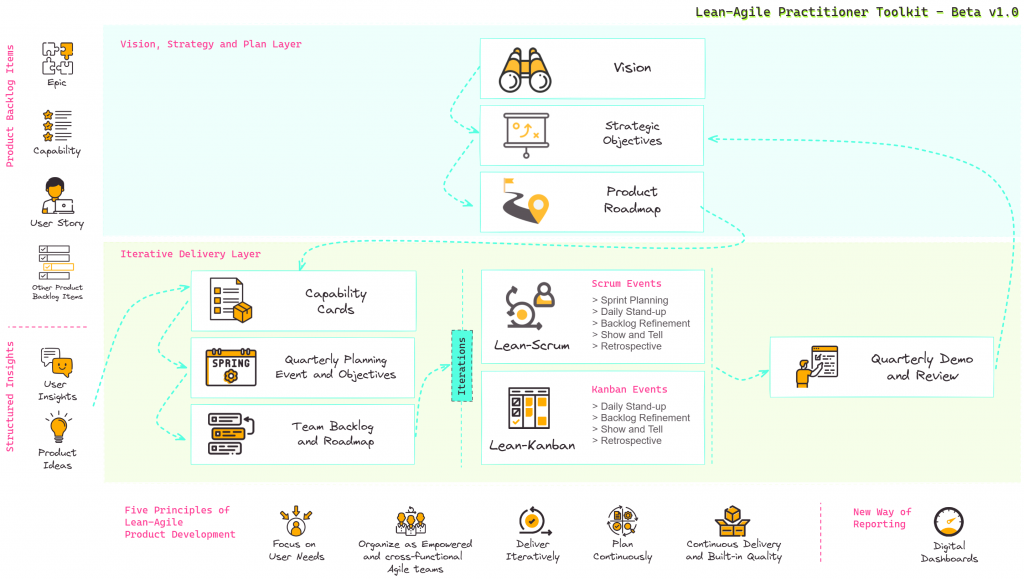Kanban is a well-known Agile product development approach that focuses on transparency and flow. It encompasses four main principles:
- Visualize the work
- Focus on continuous flow of work and optimize efficiency
- Limit the work in progress (WIP) at each stage of the flow to avoid bottlenecks
- Respect the current state of the team and team roles
Therefore, traditional Kanban doesn’t include any specific roles. It can be adapted and used alongside other methodologies. In fact, these four principles are applied by many Scrum teams worldwide. Consequently, this also helps us identify what Kanban is not, or its main differences from the Scrum framework:
- Kanban doesn’t have time-boxed iterations (Sprints) like Scrum does, therefore, it doesn’t require iterative planning and review events such as Sprint Planning or Sprint Review.
- Kanban doesn’t offer pre-defined and structured events like Scrum ceremonies.
- Kanban doesn’t have structured role definitions like Product Owner, Scrum Master, etc.
Lean-Kanban
Similar to what we explained in the Lean-Scrum section, the digital landscape has evolved significantly since Kanban’s inception. The main shifts have occurred in the following areas:
- Shifting from Project Focus to Product Mindset
- Evolving Team Dynamics
- Modern Agile Project Management Tools
- The Rise of Remote and Hybrid Work
Agile product development is now more complex and requires high-level collaboration and communication between specialized team roles. Maintaining this high level of collaboration in remote and hybrid work environments requires additional effort and adapting new tools.
Many Kanban teams worldwide are already adapting to this new reality of product development. Lean-Agile is an attempt to articulate those changes. Similar to Lean-Scrum, Lean-Kanban doesn’t replace Kanban; it builds upon it. By acknowledging the modern digital landscape and emphasizing collaboration, Lean-Kanban helps improve collaboration in Agile teams by introducing some Kanban events:
Core Principles of Lean-Kanban:
Lean-Kanban shares similar core principles with Lean-Scrum. It acknowledges the modern digital landscape, emphasizing collaboration, waste reduction, and delivering greater value to users.
- Focus on Minimum Viable Work: Prioritize delivering the smallest possible amount of work needed to achieve value and strategic objectives. Continuously ask, “Is this the minimum we can do to deliver value?”
- Time-boxed Discovery & Design: Always limit the time to spend Discovery and Design activities which includes UX/UI Design, User Research, Spikes and so on. As soon as you have enough design material or information to take to the next stage to test your learnings and assumptions, stop there.
- Release Early & Often: The fastest way to learn and improve is by putting your product in front of real users. Frequent releases facilitate this learning process.
- Transparency: UX/UI design, technical design, and some user research activities should be part of the team backlog and Kanban board.
- Collaborative Delivery of User Stories: Whenever possible and necessary, UX/UI designers, user researchers, software developers, and QA should collaborate to deliver user stories.
- Backlog Items for UX/UI Design: If UX/UI design and development activities are too large to deliver together within a single user story, create separate backlog items for UX/UI activities, ensuring careful synchronization with development activities that follow the design.
- Unified Kanban Board: Avoid using separate Kanban boards for UX/UI, user research, and development. Instead, track all activities on the Sprint board for transparency and team clarity on ongoing and upcoming work.
- Co-design Activities: Enhance collective thinking and working through co-design activities.
- User Research as a team activity: Involve diverse team members in user research by collaboratively deciding on themes and encouraging participation in user research sessions.
- Adapt to Remote Working Conditions
- Implement Necessary Agile Events: Unlike traditional Kanban, which doesn’t prescribe scheduled events, Lean-Kanban encourages the implementation of necessary Agile events. This ensures the team has defined channels for collaboration, which is especially important in today’s remote/hybrid work environments.
- Embrace Collaboration Tools: Encourage the use of collaboration tools like Slack, Confluence, Teams, etc., to facilitate communication and information sharing.


